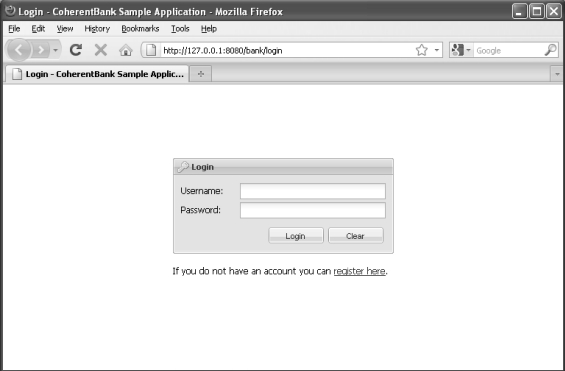-
Book Overview & Buying

-
Table Of Contents

Oracle Coherence 3.5
By :

Oracle Coherence 3.5
By:
Overview of this book
 Free Chapter
Free Chapter
 Sign In
Start Free Trial
Sign In
Start Free Trial

 Free Chapter
Free Chapter
In order to deploy the Java application, you need to perform several steps:
Open a command prompt and navigate to the CoherentBank\java directory.
Edit build.properties file to reflect your environment.
Start the H2 database:
> ant start-db-server
If everything goes well, the H2 console should open in the browser. You can log in by changing the JDBC URL to jdbc:h2:tcp://localhost/db/coherent-bank-db, setting the username to sa, and clicking the Connect button.

There will be no tables there at first, which will be corrected shortly.
Start the web application:
> ant web-app
This should run the SQL script to create necessary tables, build the application, start the embedded Jetty web server, and open up the web browser showing the login screen.

If the web server fails to start make sure that you don't have anything else running on port 8080 and retry (or alternatively, change the jetty.port property within the build.xml file).
If the browser does not open automatically, make sure that you have specified the correct browser location in the build.properties file, or open the browser manually and navigate to http://localhost:8080/bank/login.
Log in using one of the test users from the following table, or create an account for yourself by clicking on the register here link below the login form.
The test accounts that are set up by default are:
|
Username |
Password |
|---|---|
|
sele |
pass |
|
aca |
pass |
|
marko |
pass |
|
ivan |
pass |
|
mark |
pass |
|
patrick |
pass |
Play with the application—post some transactions by paying bills, look at the transaction list, edit a user profile, and so on.
Start the Coherence Extend proxy server:
> ant start-extend-proxy
This will allow C++ and .NET clients to connect to the cluster.
Optional: Run independent cache servers
By default, the web application runs as a storage-enabled Coherence node to simplify deployment, even though that is not how you would run it in production.
If you want to simulate a more realistic environment, uncomment the -Dtangosol.coherence.distributed.localstorage=false JVM argument within start-web-server target in build.xml.
However, if you do this you will need to run one or more cache servers before Step 4. You can do that by changing the startup sequence to:
> ant start-db-server > ant start-cache-server (one or more times) > ant web-app > ant start-extend-proxy

Change the font size
Change margin width
Change background colour